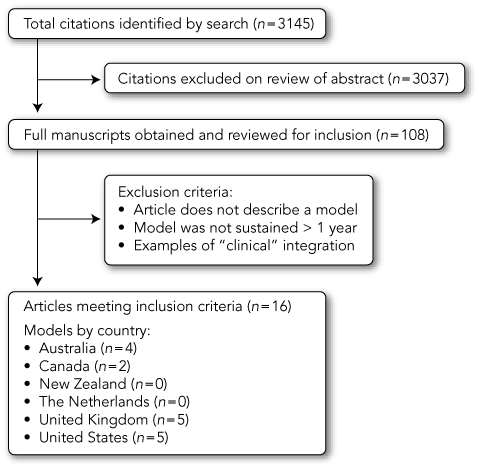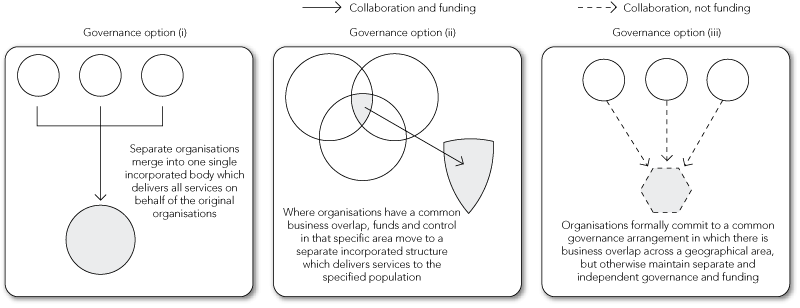[Health care] governance is like a greased watermelon — slippery and hard to grasp. It provides few opportunities for clear conceptual and empirical assessment.1
Governments, communities and health professionals are looking to new ways of delivering high-quality health care services as traditional “silo” models struggle to deliver appropriate care for an ageing population with a high prevalence of chronic disease.2 Difficulties in addressing power-sharing, funding, care models and an absence of relationship between organisations have been identified as significant barriers to such new approaches.
Integrated care requires a change in focus, from health services delivered by separate units to care that can be provided across organisations for a community or patient group. It requires general practices, hospitals, community services and consumer organisations to form effective long-term working relationships and to move beyond the occasional informal partnership to a serious commitment to integrated health care delivery. This strategic re-adjustment must be matched by a commensurate shift in inter-organisational management and governance.3-5
Integrated governance describes the formal relationship between organisations that allows them to manage deliverables, risk and process through collaborative business approaches.6 Integrated structures may exist between government agencies and across levels of government (local, state or federal) and/or the non-government sector.6 A key challenge for these emerging partnerships is managing the interaction between different modes of governance, which at some points may generate competition and at others, collaboration,7 and which lead to inherent difficulties in sustaining successful relations among diverse partners.8
Using the methodology developed by Oliver et al,9 we conducted a systematic review and key informant interviews in an integrative process.
Search terms included words or phrases relating to governance, integration, collaboration, coordination, organisation and health services management. The search strategy is described on the Australian Primary Health Care Research Institute (APHCRI) website.10
The composition of health care services delivered;
The governance structure or contractual relationship between parties, including factors such as accountability; and
The barriers and enablers associated with sustained models of governance.
We assessed the risk of bias in each of the studies using checklists appropriate to their study design. We included descriptive, qualitative and quantitative studies. The results were synthesised narratively.11
We also interviewed key informants to explore known integrated governance models currently operating in the Australian health care environment and additional activity not identified in our systematic review. The informants also identified the context for successful integrated governance approaches in the Australian health care setting.10
The search strategy identified a total of 3145 abstracts and titles, of which 16 studies met the inclusion criteria (Box 1). Further details about these studies are available from the APHCRI website.10
The 16 models of integrated governance in health care described four models from Australia, two from Canada, five from the UK and five from the United States. All of the studies were evaluations of the process of integrated governance and service delivery structures, rather than of the effectiveness of the service. The evaluations included case reports, surveys and qualitative data analyses. Nine studies addressed policy change (eg, the UK National Health Service modernisation agenda), four addressed business issues (eg, partnering to add value), and three addressed issues of clinical integration (eg, care coordination of aged patients with complex conditions). The relationship between these drivers was not examined. The studies described both governance structures and enablers of or barriers to the process of integration (Box 2). All systematic review findings were supported by findings from the interviews with key informants.
Three options for integrated health care governance appropriate to the Australian health context were identified from this approach (Box 3):
The creation of an incorporated body, with governance responsibility shared across integrating organisations and with pooled resource allocation capability for a given population or region. Examples of this type of model can be seen in Sunrise (NT) and North Wyong (NSW).10
An incorporated body established by integrating organisations, with its own funding pool and responsibility for defined areas of common business overlap between organisations.12 An example is the Advanced Community Care Association (SA).13
A formal and agreed governance arrangement between organisations to share resources by delivering services across a finite geographical area.14,15 This model is seen, for example, in Brisbane South Centre for Health Service Integration (Qld)16 and the Integrated Primary Mental Health Service (Vic).17
There is a significant and historic opportunity in the current Australian health care environment to promote sustainable integrated governance relationships focused on improved community health outcomes. Contemporary reforms to improve the health care system,2 such as the National Action Plan on Mental Health18 and the Australian Better Health Initiative,19 will require a far more significant ability to work productively between jurisdictions.
- Claire L Jackson1
- Caroline Nicholson2
- Jenny Doust1
- Lily Cheung1
- John O’Donnell2
- 1 Discipline of General Practice, University of Queensland, Brisbane, QLD.
- 2 Mater Health Services, Brisbane, QLD.
We would like to acknowledge the generous support of key health organisation executives in our key informant interviews, and the support of APHCRI in developing the model graphics.
None identified.
- 1. Savage GT, Taylor RL, Rotarius TM, Buesseler JA. Governance of integrated delivery systems/networks: a stakeholder approach. Health Care Manage Rev 1997; 22: 7-20.
- 2. Council of Australian Governments. COAG meeting, 3 Jun 2005. Australia’s health system. http://www.coag.gov.au/meetings/030605/index.htm#health (accessed Mar 2008).
- 3. Podger AS. A model health system for Australia. Part 1: directions for reform of the Australian health system. Asia Pac J Health Manage 2006; 1: 10-16.
- 4. Dwyer JM. The next Australian Health Care Agreements: what clinicians want. Aust Health Rev 2002; 25: 17-23.
- 5. Menadue J. Healthcare reform: possible ways forward. Med J Aust 2003; 179: 367-369. <MJA full text>
- 6. Institute of Public Administration Australia. Working together: integrated governance. Canberra: IPAA, 2002.
- 7. Lowndes V, Skelcher C. The dynamics of multi-organizational partnerships: analysis of changing modes of governance. Public Adm 1998; 76: 313-333.
- 8. Mitchell SM, Shortell SM. The governance and management of effective community health partnerships: a typology for research, policy and practice. Millbank Q 2000; 78: 241-289.
- 9. Oliver S, Harden A, Rees R, et al. An emerging framework for including different types of evidence in systematic reviews for public policy. Evaluation 2005; 11: 428-446.
- 10. Jackson CL, Nicholson C, Doust J, et al. Integration, co-ordination and multidisciplinary care in Australia: growth via optimal governance arrangements. Brisbane: Australian Primary Health Care Research Institute, University of Queensland, 2006. http://www.anu.edu.au/aphcri/Domain/MultidisciplinaryTeams/Final_25_Jackson.pdf (accessed Jun 2007).
- 11. Mays N, Pope C, Popay J. Systematically reviewing qualitative and quantitative evidence to inform management policy-making in the health field. J Health Serv Res Policy 2005; 10 Suppl 1: 6-20.
- 12. Peck E, Gulliver P, Towell D, et al. Governance of partnership between health and social services: the experience in Somerset. Health Soc Care Community 2002; 10: 331-338.
- 13. Advanced Community Care Association. Annual report 2004–05. Adelaide: ACCA, 2005.
- 14. Bingham P. Strategic alliances: a partnership in action. Leadersh Health Serv 1996; 5: 23-24, 44.
- 15. Campbell S. Three health care competitors cooperate to create health campus in Shakopee, Minn. Health Care Strateg Manage 1996; 14: 19.
- 16. Australian Government Department of Health and Ageing. BSCHSI–GP hospital demonstration site for Queensland. Final report. Canberra: DoHA, 2005.
- 17. Integrated Primary Mental Health Service. North East Victoria. Program evaluation II. June 2005. http://www.ipmhs.org.au/home/index.php?option=com_docman&task=cat_view&gid=60&Itemid=28 (accessed Mar 2008).
- 18. Council of Australian Governments. National Action Plan on Mental Health 2006–2011. July 2006. http://www.coag.gov.au/meetings/140706/docs/nap_mental_health.rtf (accessed Mar 2008).
- 19. Council of Australian Governments. COAG meeting, 10 Feb 2006. Better health for all Australians. http://www.coag.gov.au/meetings/100206/index.htm#health (accessed Mar 2008).







Abstract
Objective: To identify sustainable governance arrangements for health care organisations undertaking integrated health service delivery based on best available evidence.
Method: Systematic review of the literature (1990–2006), supported by key informant interviews as an integrative process.
Results: 16 studies met our selection criteria. All described enablers of and barriers to delivering integrated health services. We identified three models for integrated health care governance with a demonstrated ability to be sustained in the medium term. Common themes that emerged as the logical starting point for more ambitious integrated governance arrangements regionally were: the need for a clear separation between governance and operational management; and the need for local communities with the vision, leadership and commitment to extend health service integration. These themes were reinforced by interviews with key informants. Careful measurement of the process, impact and outcomes of such activities was often overlooked.
Conclusion: State governments are increasingly attempting to work with non-government organisations and the private sector to maximise scarce resources in the face of increasing health care demand. Ambitious integration agendas must be underpinned by effective governance mechanisms that are appropriate to the undertaking, the stakeholders involved and the scale of delivery.